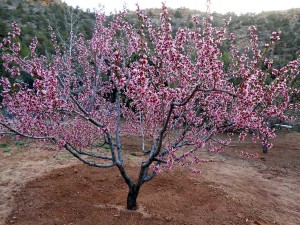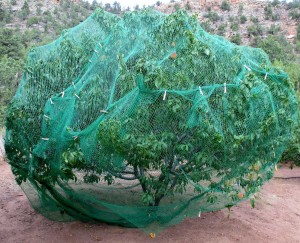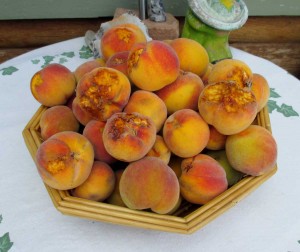We planted the ‘Reliance’ peach tree in February 2006, chosen for late season blooms that might outlive our traditional early spring frosts. We first harvested in 2010 and had so many (25 pounds) that I canned over 20 pints of the sweet juicy beauties. Local farmers raised an eyebrow at our boasting, commenting that we best enjoy our bounty, for we most probably would never see a peach again.

- The fully flowering ‘Reliance’ peach tree, considered a late season bloomer (Mar. to April) is subject to late season killing frosts (April) in our USDA Zone 5.
The tree grew in size and girth, while my husband Steve, tree professional and horticulturist, carefully pruned it each winter, fertilized the soil in spring, and applied mulch before the heat of summer. The tree grew a strong scaffold with wide and deep roots and every season brought an explosion of heavenly flowers--promises of peaches to come.
We would wait another four years before seeing a peach. The winter of 2014 is one of our coldest in record for a good many years—those same farmers exclaiming over its rarity. Imagine our delight upon seeing the peach tree in its full blooming glory in early spring. Then imagine our surprise and exuberant joy to see the ‘Reliance’ laden with the tiny, green, fuzzy peaches.

- Bird netting encapsulates the peach tree to thwart peach thieves squirrels and chipmunks and to discourage the birds that peck the ripened fruit. Clothespins close any gaps and repair holes.
Flourishing populations of birds, bees, flying insects, grasshoppers, squirrels, chipmunks, rabbits live on our little acre. We net, cover, cage and fence—everything. The mammal pests move in first. They are merciless, carrying away an entire tree full of green, hard, barely formed fruit overnight. Fruit that remains ripens to perfection. Then the birds fly in to finish off the bounty, pecking daintily from one fruit to another, like grazing at a smorgasbord.
The net goes on as soon as the fruit forms, over the entire canopy and down to the ground, anchored to the soil with irrigation tubing pins. If there is a hole in the net, even a small one, the birds get in, but can’t find their way out. The peaches dwindle, pecked remnants hanging on by just the pit.
We check the tree daily to free marauding birds and to test for ripeness, giving the peaches a gentle squeeze to see if they are softening and a sniff searching for that peachy scent. We are weary of the chores and mutter like those sage farmers, “Is it all worth it?” “Why are we doing this?”

- Even the previously pecked fruits are harvested. The chickens get the pecked pieces, but we eat every last bite of the just 10.5 pounds of perfectly tree ripened, juicy, sweet peaches.
Finally, the peaches are ready. A perfect peach is plucked from the stem. Our tradition, we stand under its shade and take turns having bites off the first peach we have grown in four years, the peach we dreamed of when we planted the sapling nine years ago. Juice running down our face, sweet nectar of the Gods down our throat, we exclaim, “When will those other four trees we planted be ready to produce?” We need to buy more netting this year!” Go figure....
Diana (Dee) Maranhao is a garden writer and horticulture editor who gardens in southern Utah. Her book, Rocky Mountain Fruit and Vegetable Gardening (Cool Springs Press, 2014) is available at most Lowe’s, Barnes & Noble, and at www.amazon.com. She can be contacted at sdmaranhao@scinternet.net.















